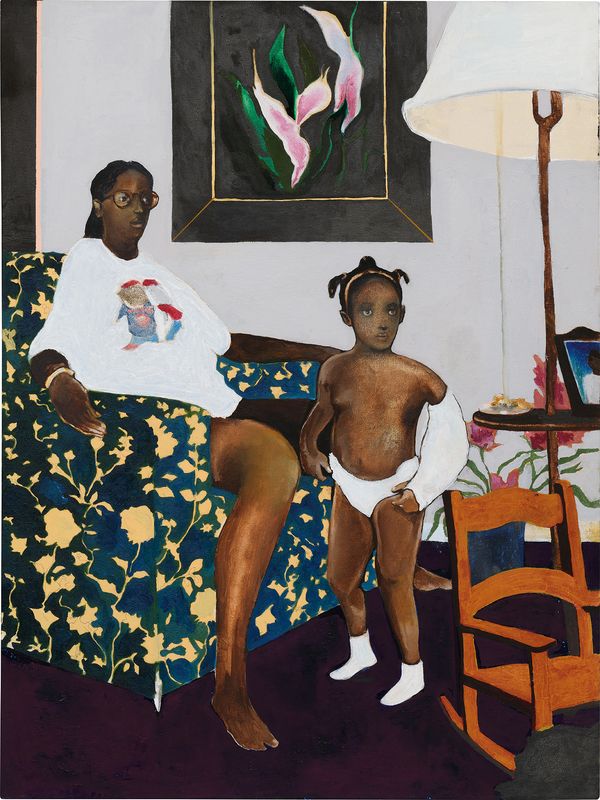Noah Davis In Search of Gallerius Maximumianus, 2009. Estimate: $60,000-80,000.
New Now at Phillips New York, 4 March.
by Mathias Rosenzweig
Works by the late Noah Davis often portray black Americans in barren, even dystopian environments tinged with surrealist elements and a humbling sense of emptiness—a void. After the artist’s passing from a rare form of cancer in August 2015, at only 32-years old, said void feels all the more palpable.
Davis was born in Seattle, Washington in 1983. His father Kevin was a lawyer, while his mother Faith worked as an educator. He was the younger of two sons and discovered his artistic inclination relatively early in life: his brother, filmmaker and video artist Kahlil Johnson, recalls Davis already having a painting studio at the age of 17. He moved to New York City to attend the prestigious Cooper Union before dropping out and moving to Los Angeles, where he got a job working in the Museum of Contemporary Art’s bookstore. He’d later partner with MOCA and have his work featured in the Rubell Family Collection, Nasher Museum of Art, LACMA, and a recent and impactful posthumous show at David Zwirner in New York.
“If I’m making any statement, it’s to just show black people in normal scenarios, where drugs and guns [have] nothing to do with it,” Davis told DAZED in 2010. “You rarely see black people represented independent of the civil rights issues or social problems that go on in the States. I’m looking to move on from that stage. We can’t keep tying our culture to a movement that happened two generations ago.”
Many of Davis’s pieces fused notions of refined culture with communities that have very little access to it. Pueblo de Rio: Concerto, 2014, for example, shows a black man playing the grand piano on the streets of a housing project in LA. Pueblo del Rio: Arabesque, 2014, similarly surreal and dreamlike, depicts six black ballerinas in that same housing project. Set under the night’s eerily purple sky, the ghostly images convey a cultural and educational potential that underserved communities, such as those living in government-assisted living, rarely are equipped to fulfill. In light of his passing, these paintings also serve as reminders of Davis’s own artistic potential, a massive loss in the collateral damage that follows such a promising young artist’s death.
Noah Davis Single Mother with Father out of the Picture, 2007-2008. Sold at Phillips New York for $168,750.
It’s no surprise that within Davis’s relatively dark and stark ethos, the topic of loss was somewhat familiar to the artist. Single Mother with Father out of the Picture, 2007-2008, conveys a depth of emotion precisely because the scenes he chooses to portray are so personal. Painting for My Dad, 2011, can be viewed as one of his personal dances with fatality after his father’s death.
“He managed with very few gestures to express emotional content and weave a story,” said Mera Rubell, who has collected many of Davis’s pieces. “The painting about his dad, it was the figure of his father carrying a lantern into this very dark cave. It captured this fading-away, into a place that no one could follow. It was a beautiful, poetic piece.”
Davis’s legacy lives beyond that of his paintings. After issues with his gallerist, Davis went on to represent himself and open the not-for-profit Underground Museum in Los Angeles. “He turned a negative into a positive…he didn’t have a pool, so he bought an ocean,” said friend and fellow artist Henry Taylor after Davis’ passing.
Cofounded by Davis’ sculptor wife Karon Davis, film producer Onye Anyanwu and brother Kahlil, the museum is situated in Arlington Heights, a working-class neighborhood. “We view this place as an experimental space that is open to the community. It used to be an old pupuseria and a church, and it had been vacant for about four years,” Davis told DAZED. “I like the idea of bringing a high-end gallery into a place that has no cultural outlets within walking distance.”
MOCA Chief Curator Helen Molesworth was fortunate enough to partner with Davis and the Underground Museum before his death. In an interview prior to his passing, she said, “Noah is an important artist because he occupies the term ‘artist’ in the largest possible way. An incredibly accomplished painter,” she continues,” he is also a profound visionary—dreaming up the idea of the Underground Museum and then physically enacting that dream against all odds.”
Davis’s In Search of Gallerius Maximumianus, 2009, will come to auction as part of our New Now sale. True to form, the 48 1/8 square inch oil on canvas depicts an eerily bodiless head, seemingly sinking into the ground in front of disembodied brown fingers. In the background, black figures in white button-downs are bent over and appear to be performing some kind of manual labor. The work embodies the juxtaposition of fantasy, tragedy and the quotidian that have set Davis' oeuvre apart in recent years.
New Now will take place on March 4th, 2020, and will also feature works from Walter Price, Ed Clark and Sarah Lucas, among other emerging, contemporary and blue-chip artists.

